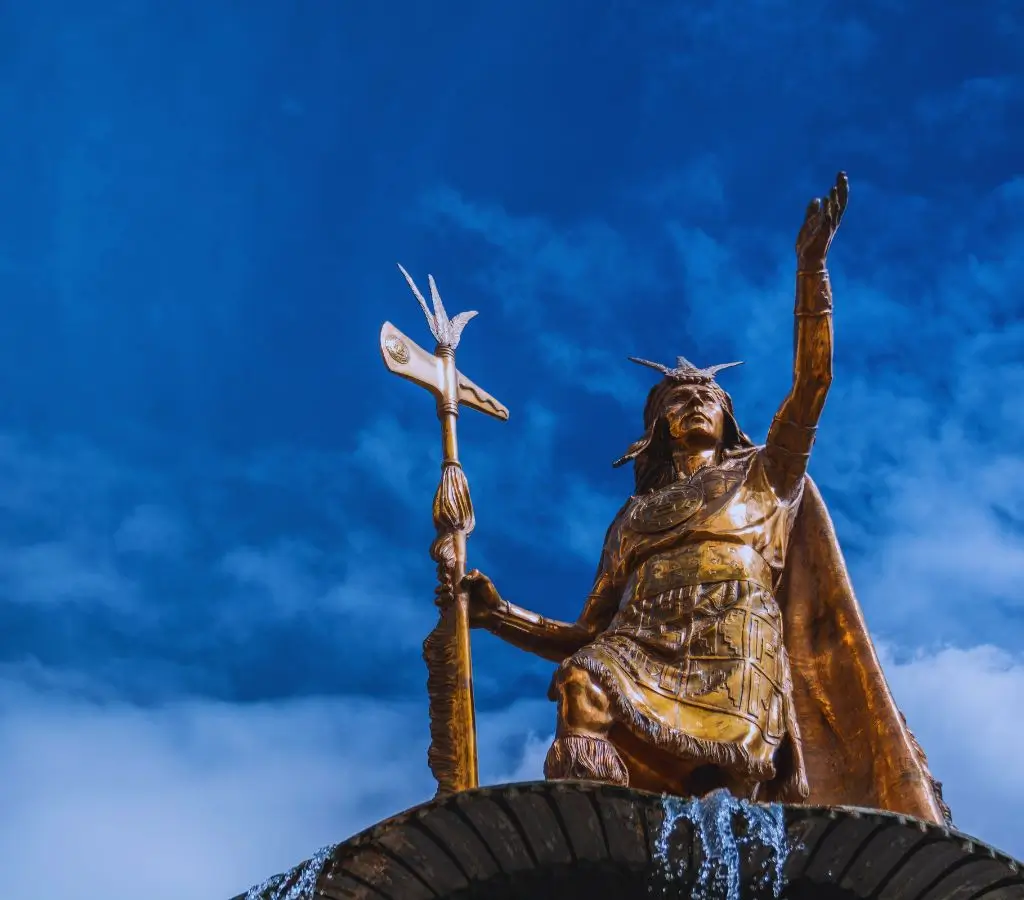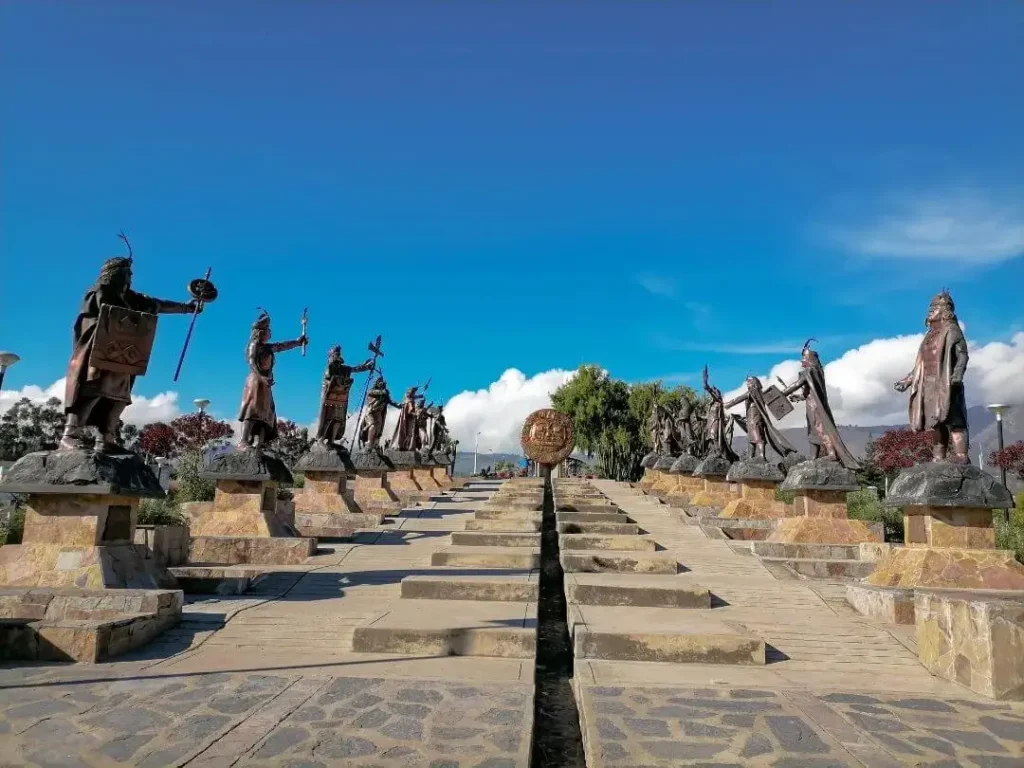The Inca Empire, also known as Tahuantinsuyo, which means "the four regions or the four suyus," was the last and the greatest pre-Columbian empire in South America. This vast empire stretched along the Andes mountain range, covering territories of what are today Peru, Ecuador, Bolivia, Argentina, Chile, and Colombia. The empire's capital was Cusco, located in present-day Peru.
The origin of the Inca Empire dates back to the 12th century, with the legendary founding of Cusco by Manco Cápac. It is believed that the Incas began as a small group that gradually expanded their influence, initially dominating neighboring peoples in the Cusco Valley and then extending their power through a combination of diplomacy, strategic marriages, and military conquests.
The Inca Empire, also known as Tahuantinsuyo, marked a milestone in the pre-Columbian history of South America. Founded by Manco Cápac around the 12th century in Cusco, it expanded through the Andes, covering current territories of Peru, Bolivia, Ecuador, Chile, Argentina, and Colombia.
Its advanced social organization, impressive architectural achievements like Machu Picchu, and efficient agricultural and road systems highlight its legacy. However, the arrival of Spanish conquerors in the 16th century marked its decline, culminating in the capture and execution of Atahualpa, the last Inca emperor.

The first Inca rulers were tasked with laying the foundations of what would become an empire. These leaders established the first laws, social organization, and the basis of the economy that would sustain the growing empire.
Manco Cápac is considered the principal founder of the Inca Empire and the city of Cusco. It is said that he emerged from Lake Titicaca along with Mama Ocllo, sent by the Sun god, to found a new kingdom that would live under the moral and ethical principles dictated by the divinity.

Following the foundation of Cusco by Manco Cápac, Sinchi Roca and then Lloque Yupanqui, his successors, focused on consolidating the power and influence of the young Inca state, improving infrastructure and alliances with neighboring peoples.
Under rulers such as Pachacútec, Túpac Inca Yupanqui, and Huayna Cápac, the Inca Empire reached its zenith, expanding to encompass a vast territory along the Andes. These leaders were not only conquerors but also great administrators and builders, leaving a legacy of impressive architectural works like Machu Picchu.

Pachacútec, whose name means "he who changes the earth," is considered one of the greatest Inca rulers. Under his leadership, the Inca Empire significantly expanded, and Cusco was transformed into a magnificent capital.
Túpac Inca Yupanqui and his successor, Huayna Cápac, continued the empire's expansion, reaching its maximum geographical extent. These rulers strengthened the empire's infrastructure, administration, and cultural cohesion through an efficient road system or Qapac Ñan and the use of Quechua as the official language.
The arrival of the Spanish in the 16th century marked the beginning of the end for the Inca Empire. The Spanish conquest, led by Francisco Pizarro, was facilitated by internal divisions within the empire, especially the civil war between Huáscar and Atahualpa.
The capture and subsequent execution of Atahualpa, the last Inca emperor, by the Spanish symbolized the final collapse of the empire. Despite resistance, especially under leaders like Manco Inca Yupanqui, Spanish control was consolidated in the region, marking the end of the Inca era.
The 14 Incas, from Manco Cápac to Atahualpa, each contributed to the formation, expansion, and consolidation of the Inca Empire. Their reigns are marked by significant achievements in terms of administration, conquests, and architectural and agricultural developments.
Considered the legendary founder of the Inca Empire, Manco Cápac is a figure shrouded in mystery and mythology. It is said that he emerged from Lake Titicaca, guided by the Sun god, to establish the city of Cusco and lay the foundations of the empire. His leadership is remembered as the beginning of a golden age, marking the start of a dynasty that would transform the Andean region.
Sinchi Roca, the successor to Manco Cápac, is often remembered for consolidating the power of the young empire and expanding its domains through diplomacy rather than conquest. His reign is less documented, but he is credited with strengthening the Inca's social and political structure.
The third Inca, Lloque Yupanqui, is notable for continuing the work of his predecessors, strengthening the empire and expanding its territory into the Sacred Valley of Cusco. He is attributed with improvements in agriculture and administration, as well as the establishment of laws that helped maintain peace and order.
Mayta Cápac is recognized for his warrior character, conducting several military campaigns that significantly expanded Inca territory into the highlands and integrating the citadel of Tiahuanaco. His reign marked a turning point, demonstrating the empire's potential for expansion and conquest.
Under the leadership of Cápac Yupanqui, the Inca Empire continued its expansion, notable for his campaigns on the coast or the Hurin Qosqo. He is considered one of the empire's first great military strategists, who also promoted the development of new agricultural technologies.
Inca Roca, with the beginning of Hanan Qosqo, is remembered for his focus on the internal consolidation of the empire and the implementation of administrative reforms. His reign was characterized by a greater emphasis on political, social organization, education, and religion. In architecture, he is known for his water channeling works.
The reign of Yahuar Huacac was marked by tragedy and conflict, including the legendary capture and eventual rescue of his son. Despite these challenges, he managed to maintain the stability of the empire and is remembered for his dedication to the Sun deity.
Viracocha faced significant challenges, including external invasions from the Chanca civilization that tested the empire's strength. Despite some defeats, his legacy includes the reconstruction and fortification of Cusco, laying the groundwork for a renaissance era under his successor.
Pachacútec, "the world transformer," is one of the most celebrated rulers of the Inca Empire. His vision and leadership not only vastly expanded the empire but also initiated monumental architectural projects, including Machu Picchu, and reformed Inca society, laying the foundations for modern Cusco.
He also established the official language, reorganized the four suyus, was a great administrator, and developed the accounting Quipu.
Amaru Inca Yupanqui is often considered a transitional leader, maintaining his predecessor's conquests while paving the way for his successor's expansive campaigns. His reign is less documented, but he contributed to the consolidation of Inca power.
Túpac Inca Yupanqui is revered for his extraordinary military campaigns that expanded the empire to the north and south, reaching its maximum geographical extent. His ability to integrate new peoples into the empire and his interest in maritime exploration are noteworthy, as his expansion reached as far as Chile.
Huayna Cápac consolidated his father's conquests and maintained the empire at its peak. Despite facing challenges, such as an epidemic that affected the population, his reign is characterized by stability and prosperity.
Huáscar's reign was marked by a devastating civil war against his brother Atahualpa, significantly weakening the empire on the eve of Spanish conquest. His power struggle reflects the internal tensions that would ultimately facilitate foreign conquest.
Atahualpa, the last Inca, is infamously known for his capture and execution by the Spanish conquerors. Despite his brief reign, his figure symbolizes the end of an era and the beginning of another under Spanish rule.
The Inca society was highly organized, with an economy based on agriculture and a resource redistribution system. Life in the Inca Empire was governed by strict laws, and the Sun was worshipped as their supreme deity.
They had a type of ideology that many researchers continue to study today, as they also venerated the Apus or Mountain Angels. At the same time, they did not see gold as it is seen today, but rather it represented the tears of the Sun, hence its importance at that time.
Here is the classification of the lifestyle:
Inca society was hierarchically organized in a hierarchical system, with the Sapa Inca at the top as the divine ruler. Followed by the nobility, which included conquest leaders, provincial administrators, and priests. The majority of the population were peasants, artisans, and traders, who owed tribute to the state through labor (mita) on agricultural lands, construction projects, and the army.
The Inca economy was based on agriculture, highlighting the cultivation of potatoes, corn, quinoa, and coca on Andean terraces to maximize agricultural space. The state controlled the production and distribution of goods through a system of warehouses to ensure that no one went hungry and to be prepared in times of scarcity. Additionally, the domestication of llamas and alpacas played a crucial role in transportation and wool production.
The Incas are renowned for their achievements in engineering and architecture, building extensive road networks (Qhapaq Ñan) that connected the empire, facilitating communication, trade, and military movement. The impressive mortarless stone constructions, like Machu Picchu, are a testament to their advanced architectural technique.
Religion played a central role, worshiping the Sun (Inti) as their main deity. The Incas believed in the afterlife, so the mummies of past rulers were cared for and venerated. Religious ceremonies and sacrifice rituals were common, seeking harmony between the natural and supernatural worlds.
Despite not having a writing system, the Incas used quipus, a system of cords and knots for record-keeping and information transmission. Education was primarily reserved for the nobility, where young people learned about culture, religion, history, and the administration of the empire.
Today, the fascinating history and impressive archaeological remains of the Inca Empire attract visitors from all over the world. Places like Machu Picchu, the Sacred Valley of the Incas, and the city of Cusco itself offer a unique window into the glorious past of this civilization.
Our tourism packages are designed to provide an unforgettable experience, combining adventure and culture, and allowing travelers to explore the heart of the ancient Inca Empire, learning about its history, architecture, and the life of its people.


